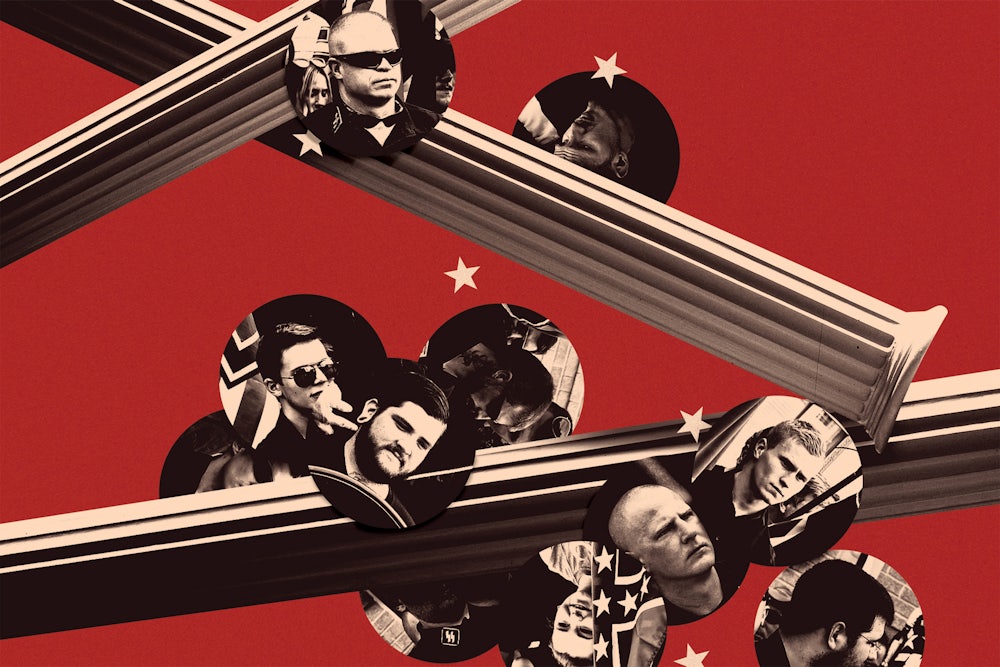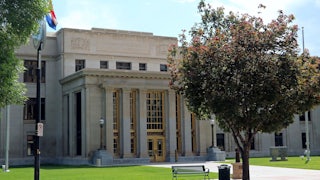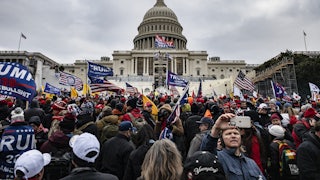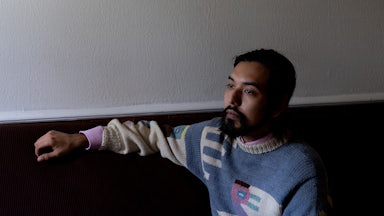It is a risky business to try to parcel American politics into periods, especially American conservative politics. As popular writers like Rick Perlstein or, more recently, John Ganz have noted, many of the most seemingly distinctive elements of the current era have deep roots. American nativism is as old as America, and from Goldwater and Reagan to stranger figures like Ross Perot, the character of the charismatic “outsider” who promises to come in and bust up the establishment, the Beltway consensus, the deep state, whatever, is a common animal in our political bestiary.
Nevertheless, if we are to date the present epoch to the start of Donald Trump’s unlikely 2016 presidential campaign, then what emerges as perhaps its defining structural feature is the increasingly stark geographic sorting of American ideology and voting habits. This is the so-called urban-rural divide, which expanded after Bill Clinton won the last geographically diverse presidential election, deepened mightily through the 2000s and 2010s, and has now become a chasm in American electoral politics.
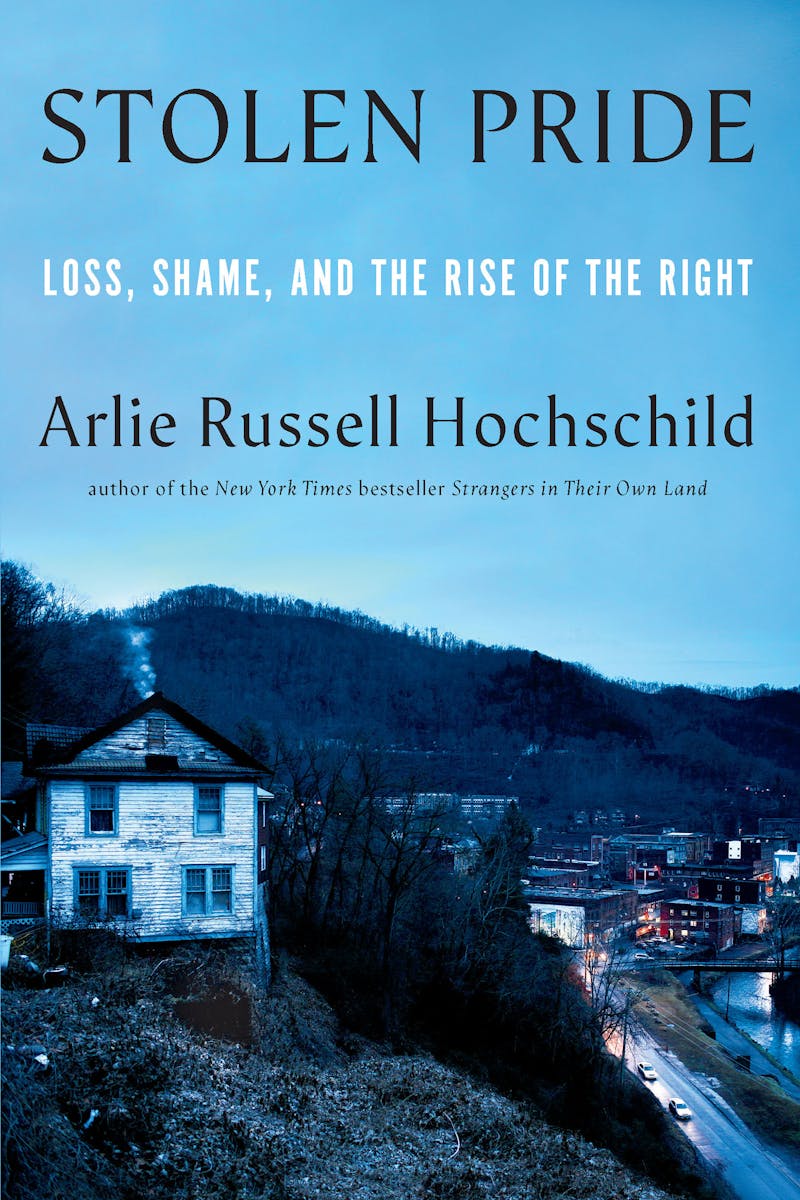
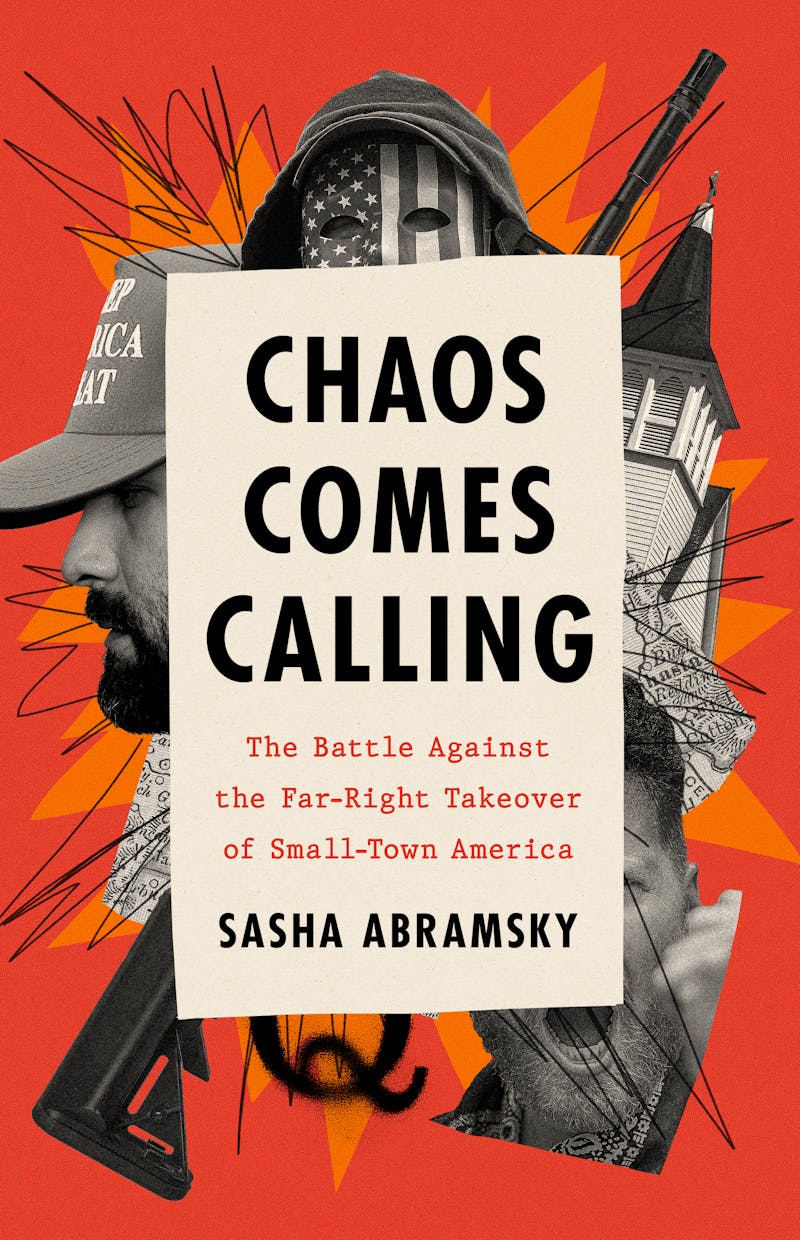
The question of why this occurred—why rural voters, specifically white rural voters, have abandoned the Democratic Party en masse—sent a whole cohort of commentators into a panic in 2016. The class of people—writers, pollsters, TV talkers, journalists—whose job is to perform a delicate meteorology on the colliding fronts and barometric pressures of American politics experienced a crisis of confidence. They dispersed into the flat states, the small towns, the eight-lane exurbs that had just made a mad clown the president and set about trying to understand the social psychology of some real, Völkisch Americans whose angers, biases, and demands must be true because, well, after all, they won. You know the scene. A New York Times reporter walks into a rural diner in Indiana. It sounds like the setup to a joke, because it is.
Likewise, this question has already produced a small library of literature. The past year saw a contretemps as Colby College professors Nicholas F. Jacobs and Daniel Shea published The Rural Voter: The Politics of Place and the Disuniting of America, a long, measured argument about how some unique characteristics of rural communal identity (among other factors) and patterns of investment and disinvestment undergird this geographic polarization. This was followed in early 2024 by White Rural Rage: The Threat to American Democracy, by University of Maryland poli sci professor Thomas Schaller and American Prospect columnist Paul Waldman, which proposed that the pathologies of rural whites—anger, racism, violent separatism, and fanaticism—represent a unique and urgent threat to American democracy itself, and which argued that academics and the mainstream press were dangerously overgenerous in their attempts to understand, rather than condemn, this disordered worldview. They were in short order accused by Shea and others of misrepresenting the academic research, and they, in turn, in the pages of this magazine, accused the researchers of engaging in a discourse of “shouts and whispers.... Find no difference between the political attitudes of rural whites and other Americans, or show that they have admirable values? Shout it from the rooftops. Uncover transgressive political beliefs among rural whites? Whisper it at a conference panel with a dozen people in attendance and no media to be found.”
Two new books take up the debate over America’s geographic divide and complicate it. Stolen Pride: Loss, Shame, and the Rise of the Right, by the highly regarded Berkeley sociologist Arlie Russell Hochschild, forms a sort of diptych with her 2016 Strangers in Their Own Land, which examined the Tea Party movement by embedding in the community of Lake Charles, Louisiana. This new volume takes an ethnographic look at Appalachian communities in eastern Kentucky, particularly Pikeville, around a moment when far-right figures are organizing a white nationalist march through the town. Sasha Abramsky, a peripatetic British journalist who has written widely on life in America, particularly on U.S. prisons, has turned in the more straightforwardly journalistic Chaos Comes Calling: The Battle Against the Far-Right Takeover of Small-Town America. Abramsky alternates between small communities in Northern California and Washington’s Olympic Peninsula, where, beginning in the strange and dislocating early days of the pandemic, the local far right began a series of putsches to take over mayor’s offices, city councils, election boards, and school districts.
Stolen Pride is less academic than The Rural Voter, and Chaos Comes Calling is less polemical than White Rural Rage, but they are similar to those works in their respective emphases. Abramsky’s cast of conservative characters is often quite odious, and while he is sympathetic to some, he is willing to paint others plainly as villains, driven mad by the right-wing media and insane conspiracy theories and willing to go to extraordinary, vile lengths to threaten, intimidate, and denigrate their opponents. Hochschild doesn’t shy away from presenting her own subjects’ more troubling views, but her own villains tend to come across as more pathetic and dismal than frightening or dangerous, and they ultimately receive a kind of clinical generosity. Hochschild seeks to explicate; Abramsky wants to expose.
The former tendency, which drives some readers of those New York Times diner pieces to distraction, attempts to give voice to its rural conservative subjects and to let them explain themselves. To critics, this is malpractice, bordering on apology. Should voters who support politicians and policies that look, at least fuzzily, like fascism, be given a blank page onto which to write their grievances in the most sympathetic possible light? I am often one of those frustrated readers myself, but I don’t think the approach can be dismissed out of hand. Whether or not we call Trump’s movement fascism, what it shares with fascism is that it is intensely personal—personal in its singular focus on the character of Donald Trump, but also personal in the sense that it arises from exceptionally personal sets of particularized grievances, prejudices, disappointments, and idiosyncratic beliefs. And Hochschild is a skilled and careful interlocutor.
Abramsky takes a different approach—more episodic, and more narrative. He also lets the people of rural Washington and California speak for themselves (for better and for worse), but he is doing something that Hochschild generally is not: He is telling a story about the very specific, and sometimes very harrowing, political consequences of these right-wing beliefs. He is less interested in diagnosing the psychosocial origins of conservative reaction than in examining the way reactionaries change and impact the communities where they put their ideas into action. And in a few cases, he is interested in what amounts to a communal course of treatment.
Hochschild’s wide-ranging portrayals of the residents of an Appalachian community—from businesspeople to recovering addicts, university administrators to prisoners—are sympathetic, fascinating, sometimes funny, and often quite moving. Hochschild had, she writes, “come to Pikeville with a growing concern about the nation’s growing political divide, a keen interest in an unfamiliar place, and an idea about emotion in politics that I thought could illuminate the storm I felt brewing.” The explanatory task she sets for herself is daunting, because she finds that so much of this idea about emotion in politics grows out of a fundamental paradox in the conservative worldview. On the one hand, a sense of deservingness, a belief that they are owed access to an American Dream of wealth, prosperity, and respect; on the other hand, a sense of unworthiness, grounded in a belief that hard work is rewarded and those without rewards aren’t working hard enough.
The time Hochschild spent in Pikeville coincides with a white nationalist attempt in 2017 to organize a march in the town, led by a neo-Nazi named Matthew Heimbach. Why Pikeville? It is not entirely clear, even to Heimbach himself, who originally hails from a D.C. exurb. He was, he claimed, “focusing on his ‘grassroots brothers’ from Appalachia,” and it seems that he and his allies mostly just saw the poor, relatively ethnically and racially homogeneous community as a naturally sympathetic audience for their views. (They overestimate its homogeneity. There are longtime Black residents, Jews; a well-known doctor is a Muslim immigrant.) Hochschild treats Heimbach—who months later attended the deadly “Unite the Right” rally in Charlottesville, Virginia—relatively gently, and gives him a lot of space to expound upon his own rather pat origin story (distant father, self-diagnosed autism), including one anecdote, rather questionable to my ears, about a Black student threatening his schoolteacher mother with a gun in order to get a passing grade. She seems to see in this ungainly, dyspeptic young man a bit of a skeleton key—a person in whom pride and shame are so tightly wound that they cannot be untangled, with results both ugly and wildly incoherent.
Hochschild’s generosity toward her subjects isn’t necessarily a drawback—it is a sociologist’s tool, and she sometimes allows people just enough rope to hang themselves. One pro-Trump, pro-coal organizer, for example, is given a great deal of space to expound in calculated and reasonable tones about the values of his community and to portray himself as fundamentally moderate, thoughtful, and reasonable ... until, in a concluding chapter, she permits him to reveal that he in fact admires the “illiberal democracy” of Viktor Orbán’s Hungary.
Many of Hochschild’s conclusions are sound but not particularly striking. She observes both here and in Strangers in Their Own Land that many of her subjects feel that others—minorities, immigrants, etc.—are somehow “cutting in line,” and she remarks that this notion, however incorrect, is a powerful motivator of political reaction, especially in impoverished communities. As she notes, many residents of these communities do go into cities, some of them in patterns of almost seasonal vocational migration, and see the scope and scale of investment—buildings; roads; airports; restaurants—and then return to the hollowed-out, deindustrialized landscape of the post-extraction economy. Hochschild identifies a “pride paradox”: Americans do want to live with pride and with dignity and find themselves simultaneously proud of their community and its values and ashamed of its poverty and disintegration.
Yet the book has a regrettable tendency to fit people into this schema in ways that can feel both narrow and, frankly, a bit naïve. She finds many cases of the “pride paradox,” like Alex Hughes, a small entrepreneur who “yes-sure’d” his way into jobs and businesses—self-training and picking up work others wouldn’t or couldn’t do—until “by the 1990s Alex’s bootstrap ‘yes sure’ strategy no longer brought in steady work,” and he found himself divorced, underemployed, and $128,000 in hock to the IRS. Like many of the Pikeville residents Hochschild meets, Hughes purports to want nothing to do with the white nationalists. He tells her, “I am three emergencies past a deadline at a job that I worry I could lose”; he has no interest in “racial strife.” But like 80 percent of Pike County, he voted for Donald Trump, who showed scarcely less animosity toward racial minorities or immigrants than did the Nazis at the march. I couldn’t help but wonder if the paradoxes Hochschild identified were really explanations, or if they were just excuses and justifications all along.
Some of this empathy begins to feel like special pleading. I grew up in one of these communities. Uniontown, Pennsylvania, was not quite as small as Pikeville (though it may be even poorer), but it was still an old coal-and-coke town with a dying main street, whose population had declined from more than 20,000 in the ’40s and ’50s to barely 12,000 when I was in high school there in the ’90s (and continued to decline to under 10,000 today). There were, and are, plenty of good and noble people, but, as anyone in Fayette County, Pennsylvania, or anywhere like it, will also happily volunteer, there are plenty of assholes. (Abramsky’s book is more forthright on this point.) You don’t need to embrace the full thesis of a book like White Rural Rage, or even Thomas Frank’s What’s the Matter With Kansas, to see that for some people at least, the cruelty is the point, as The Atlantic’s Adam Serwer put it. Sophisticated racists with an understanding of journalism and, to some extent, social science are capable of invoking terms such as disinvestment and material deprivation as little more than a convenient excuse for their corrosive beliefs. We should be careful not to be too readily taken in by self-representation—a weakness, perhaps, in the ethnographic form itself.
We should also be mindful that, while rural regions vote in much higher percentages for Republicans than other parts of the country do, there are plenty of reactionary conservative voters in rich metropolitan areas. More than 650,000 New York City residents voted for Donald Trump last time around, more votes than he received in the entire state of West Virginia. I am unconvinced that the reactionary mind, as the political scientist Corey Robin has called it, can be understood straightforwardly as a matter of either communal principles or a deficit of personal pride. The reactionary’s persistent idea that there is a single, correct, and unchanging hierarchy of peoples, races, religions, genders, and modes of living is more complex, durable, and difficult to untangle. This is why, I think, books like Hochschild’s particularly struggle to explain the people that the historian and podcaster Patrick Wyman has referred to as the “local gentry,” the wealthy upper crust that sits atop even the poorest communities and keeps the country clubs and golf courses afloat. In the poorest pockets of America, there are still very rich people who very much understand that their positions are strengthened and maintained by keeping the poor down and by keeping the poor angrier and more suspicious of one another than they are of the local bosses.
It is notable, too—as recent research from Cornell University has shown—that there is no major equivalent polarization among nonwhite rural populations. They vote, by and large, like their urban and suburban counterparts. Why should rural Black populations, for example, who likewise often live in some of the poorest and most disinvested places in America, not perceive themselves as being left behind by an urban professional elite? And if they do, why is their wounded pride not a gateway to conservative reaction? In any case, the concatenation of rural whites and the working class into that curious amalgam, “the white working class,” cleverly elides the true character of the actual American working class, which is as likely to be a Black woman service employee or a seasonal Latino agricultural worker as it is to be a white man in a traditional industrial or extractive trade.
Chaos Comes Calling is therefore a useful counterbalance to Stolen Pride. Focusing mostly on the emergence of Covid and its odd aftermath, Abramsky captures a grab bag of political beliefs that can—and did—twist into some quite ugly formations. “Jaman’s politics were difficult to categorize,” he writes in a typically arch and understated fashion, as he describes the transformation of an 81-year-old Port Townsend, Washington, resident named Julie Jaman from anti-Vietnam protester and “granola personality” to an anti-vaccine conspiracist and, finally, to a screaming bully who emerges naked and still dripping from a locker-room shower to demand whether transgender staff of the local Y have penises.
And for every batty and dismissible Julie Jaman, there is a William Armacost, a rabidly reactionary “hair-salon owner and motorcycle aficionado” who wears a Punisher pin and peddles QAnon conspiracies. He becomes mayor of the small town of Sequim, Washington, in a series of elections and council maneuvers that no one seemed to pay attention to at the time, and then he relentlessly and heedlessly pursues, harasses, and threatens city civil servants, political enemies, and, really, anyone who gets in his way or looks at him wrong. His type—mostly, though not exclusively, male; vindictive; prone to intimations of violence; unwilling to brook dissent; dismissive; mocking; and plain mean—recurs throughout the book. Such men often seem driven, like Donald Trump himself, by a poisonous combination of personal vanity and inadequacy. They delight to see others suffer harm. They are not the forgotten men of the hollers.
The public dialogue grows harsher and more vulgar. Chaos Comes Calling jumps back and forth rapidly between Shasta County, in California, and the small communities of the northern Olympic Peninsula. Much of the story is a ratchet of tension and threat, as, beginning with pushback to local and state mask mandates, extreme right-wing figures in both communities colonize and take over local governments, school boards, and libraries. There is a grim undercurrent of possible violence—these communities are rural, and they are heavily armed.
Abramsky connects some of this change to the pandemic, still a great, unprocessed national trauma, a catastrophe that frayed a national psyche barely recovered from the awful economic dislocations of deindustrialization and the Great Recession and driven to distraction by the derangements and bitter political acrimony of the Trump presidency. Taken together, these cyclical and mutually reinforcing disasters, wherein the government seemed to fail, did fail, again and again, created a fertile territory for a whole set of unresolved national sins and conflicts to rear up in new and nasty ways. “We all have to ask ourselves, are we becoming so ensconced in the ideologies we believe that we’re becoming terrible people?” laments Jodi Wilke, a nurse and community activist from Port Hadlock-Irondale, Washington. “People who say ‘you should get that vaccination or I hope you die.’ How far is that from what happened in Germany” in the Nazi era?
Chaos Comes Calling is not entirely despairing. Abramsky also shows us the people who oppose this change in their communities. Doctors who work despite the threats. Local liberals, and even a few last moderate Republicans. The lives of these political minorities tell a different story than the ones we are used to reading in the sociology of Trump country genre. The leftists and liberals here come to, or stay in, rural places because they are beautiful, because they are quiet, because they are where they and their families grew up. In such places, leftists, liberals, and moderates are often made to suffer the very unkindnesses and indignities that conservatives so often claim as their own unique lot. Conservatives worry about some vague consequences if they post something racially insensitive on Facebook, while Doni Chamberlain, a local liberal journalist who runs a bumptious muckraking blog called A News Café—“Northern California’s Premier Online News Magazine”—is manhandled out of an event for a new local far-right organization and then escorted from the premises by the California Highway Patrol.
To some extent, the right-wing takeovers were as much the result of inattention and Democratic Party ineffectualness as anything. “Despite showing for national elections, local Democrats were slow off the mark when it came to local politics,” Abramsky observes. “They didn’t field comprehensive slates of candidates for city council and other regional offices, apparently not realizing until late in the day just how much of an electoral threat extremists at the local level had become.” The Democrats! In Sequim, though, a local alliance of good-government types managed to take back significant control in subsequent elections. Powered by grievance and driven only to punish, the far right had forgotten to fix sidewalks and pave roads.
What is the right approach to the far right? What is the right tool? Is it the scalpel, or the psychiatrist’s couch? Is the far right something to be excised from the body politic, or something to be talked through and understood and maybe cured? Stolen Pride is a useful and often fascinating contribution to our understanding of “the rise of the right” in rural America, but it is by laying bare the very real, human, social, moral, and economic consequences of putting their extreme beliefs into practice that Abramsky makes perhaps the more incisive contribution. It is all fine and well to ask why people believe what they do, but you have to follow through and see what happens when they get the keys to city hall.
In the end, these approaches are probably both necessary and complementary. This is not a problem that will soon go away. The right is very angry, and very well-established. Despite the recent apparent turn of Democratic fortunes with the nomination of Kamala Harris and the return of a competitive national electoral environment, I am profoundly doubtful that the fever will simply break, that, as some hope, the political center has learned a few lessons and is up to the task. Whether we suffer in this country from a surfeit of pride or from a deep deficit, I worry that pride is a central and necessary component of whatever it is we call the American Dream. That is indeed a problem. What comes before destruction, and a fall?
